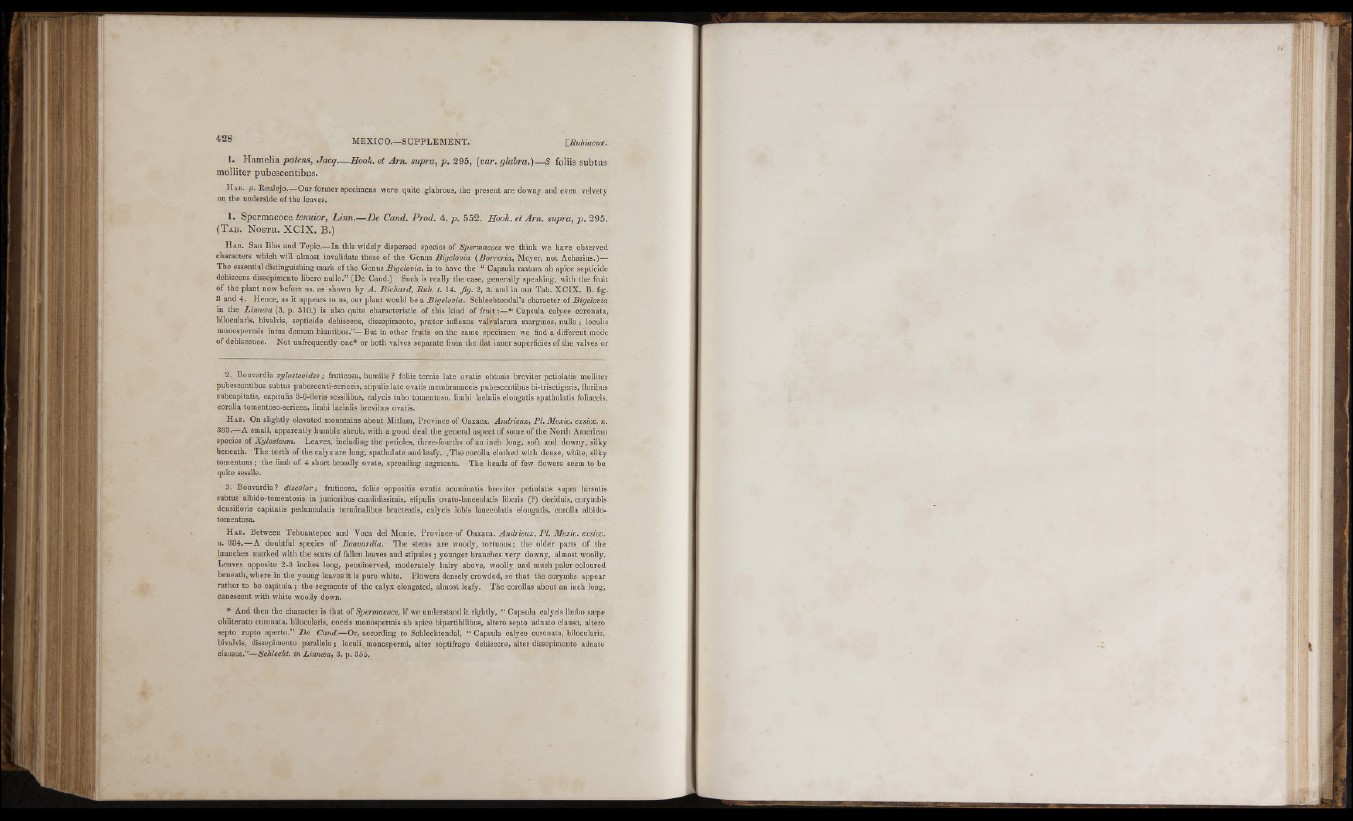
M EX IC O .-SU P P L EM EN T . [Rubiacece.
1. Hamelia patens, Jacq.—Hook, et Arn, supra, p . 295, {var. glabra.)—3 ioliis subtus
molliter pubescentibus.
H a b . ^.Realejo.— Our former specimens were quite glabrous, tbe present are downy and even velvety
on the underside of the leaves.
1. Spermacoce tenuior, Lin n .— D e Cand. Prod. 4. p . 552. Hook, et A m . supra, p . 295.
{ T a b . N o s t r . X C IX . B.)
H a b . San Bias and Tepic.—In this widely dispersed speeies of Spermacoce we think we have observed
characters which will almost invalidate those of the Genus Bigelovia {Borreria, Meyer, not Acharius.)—
The essential distinguishing mark of the Genus Bigelovia, is to have the “ Capsula matura ab apice septicide
dehiscens disseplmento libero nullo.” (De Cand.) Such is really the case, generally speaking, with the fruit
of the plant now before us, as shown by A . Richard, Rub. t. 14. Jig. 2, 3. and in our Tab. XCIX. B. fig.
3 and 4. Hence, as it appears to us, our plant would be a Bigelovia. Schlechtendal’s character of Bigelovia
in the Linnæa (3. p. 310.) is also quite characteristic of this kind of fruit :—“ Capsula calyce coronata,
bilocularis, bivalvis, septicide dehiscens, dissepimento, præter inflexos valvularum margines, nullo ; loculis
monospermis intus demum hiantibus.”—But in other fruits on the same specimen we find a different mode
of dehiscence. Not unfrequently one* or both valves separate from tbe flat inner superficies of the valves or
2. Bouvardia xylosteoides ; fruticosa, humilis ? foliis ternis late ovatis obtusis breviter petiolatis molliter
pubescentibus subtus pubescenti-sericeis, stipulis late ovatis membranaceis pubescentibus bUtrisetigeris, floribus
subcapitatis, capitulis 3-6-floris sessilibus, calycis tubo tomentoso, limbi laciniis eiongatis spathulatis foliaceis,
corolla tomentoso-serieea, limbi laciniis brevibus ovatis.
H a b . On slightly elevated mountains about Mitlam, Province of Oaxaca. Andrieux, PI. M exic. exsicc. n.
333.—A small, apparently humble shrub, with a good deal the general aspect of some of the North American
species of Xylosteum. Leaves, including the petioles, three-fourths of an inch long, soft and downy, silky
beneath. The teeth of the calyx are long, spathulate and leafy. .The corolla clothed with dense, white, silky
tomentum ; the limb of 4 short broadly ovate, spreading segments. The heads of few flowers seem to be
quite sessile.
3. Bouvardia? discolor; fruticosa, foliis oppositis ovatis acuminatis breviter petiolatis supra hirsutis
subtus albido-tomentosis in junioribus candidissimis, stipulis ovato-lanceolatis liberis (?) deciduis, corymbis
densifloris capitatis pedunculatis terminalibus bracteatis, calycis lobis lanceolatis eiongatis, corolla albido-
tomentosa.
H a b . Between Tehuantepec and Voca del Monte, Province of Oaxaca. Andrieux, PI. Mexic. exsicc.
n. 334.—A doubtful speeies of Bouvardia. The stems are woody, tortuous; the older parts of the
branches marked with the scars of fallen leaves and stipules ; younger branches very downy, almost woolly.
Leaves opposite 2-3 inches long, penninerved, moderately hairy above, woolly and much paler coloured
beneath, where in the young leaves it is pure white. Flowers densely crowded, so that the corymbs appear
rather to be capitula; the segments of the calyx elongated, almost leafy. The corollas about an inch long,
canescent with white woolly down.
, * And then the character is that of Spermacoce, if we understand it rightly, “ Capsula calycis limbo sæpe
obliterato coronata, bilocularis, coccis monospermis ab apice blpartibilibus, altero septo adnato clauso, altero
septo rupto aperto.” De Cand.—Or, according to Schlechtendal, “ Capsula calyce coronata, bilocularis,
bivalvis, dissepimento parallelo ; loculi monospermi, alter septifrage dehiscens, alter dissepimento adnato
clausus.”—Schlecht. in Linnæa, 3. p. 355.